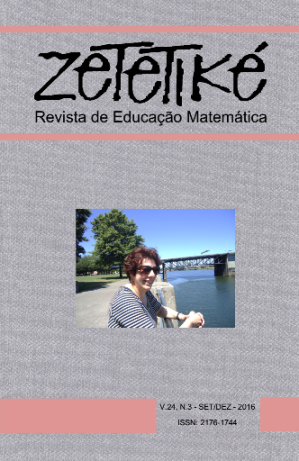Resumo
El objetivo de este artículo es evidenciar y caracterizar las relaciones entre distintos subdominios del conocimiento matemático especializado del profesor de matemáticas. Particularmente, buscando la mejora de la práctica del profesor, estas relaciones y su rol en la práctica tienen relevancia en las situaciones matemáticamente críticas, una de las cuales se refiere a la enseñanza y el aprendizaje de los números racionales. Considerando el conocimiento del profesor desde el modelo Mathematics Teachers Specialized Knowledge, se identifican y se caracterizan las relaciones entre uno de los subdominios (Knowledge of Mathematics Teaching) y los demás subdominios del conocimiento del profesor de matemáticas, en la práctica de una profesora chilena (8º grado – alumnos de 13-14 años), en el tema de los números racionales. Se concluye presentando estas relaciones mediante mapas de conexiones entre los subdominios del modelo.Referências
Ball, D. L., Thames, M. H. & Phelps, G. (2008). Content knowledge for teaching: what makes it special? Journal of Teacher Education, 59(5), 389-407.
Behr, M.J., Lesh, R., Post, T.R., & Silver, E.A. (1983). Rational number concepts. In R. Lesh & M. Landau (Eds.), Acquisition of mathematics concepts and process (pp. 91-126). New York: Academic Press, Inc.
Carrillo, J., Climent, N., Contreras, L. C. & Muñoz-Catalán, M. C. (2013). Determining Specialized Knowledge for Mathematics Teaching. In B. Ubuz, C. Haser, & M. A. Mariotti (Eds.), Proceedings VIII Congress of the European Society for Research in Mathematics Education (CERME 8) (pp. 2985-2994). Antalya: Middle East Technical University, Ankara.
Cohen L. & Manion L. (2002). Métodos de investigación educativa. Madrid: La Muralla.
Escudero-Avila, D. (2015). Una caracterización del conocimiento didáctico del contenido como parte del conocimiento especializado del profesor de matemáticas de secundaria. Tesis doctoral. Huelva: Universidad de Huelva.
Flores, A. (2002). Profound understanding of division of fraction. In B. Litwiller & G. Bright (Eds.), Making sense of fractions, ratios, and proportions: 2002 Yearbook (pp. 237-246). Reston: NCTM.
Flores-Medrano, E., Escudero-Avila, D., Montes, M., Aguilar, A. & Carrillo, J. (2014). ¿Cómo se relaciona el conocimiento que tiene el profesor acerca del aprendizaje de las matemáticas con su entendimiento sobre los Espacios de Trabajo Matemático? En I. Gómez-Chacón, J. Escribano, A. Kuzniak & P.R. Richard (Eds.), Proceedings Fourth ETM Symposium (pp. 473-485), Madrid, España.
Graeber, A., Tirosh, D., & Glover, R. (1989). Preservice teachers’ misconceptions in solving verbal problems in multiplication and division. Journal for Research in Mathematics Education, 20(1), 95-102.
Harel, G., Behr, M., Post, T., & Lesh, R. (1994). The impact of number type on the solution of multiplication and division problems: Further considerations. In G. Harel & J. Confrey (Eds.), The development of multiplicative reasoning in the learning of mathematics (pp. 365-388). Albany, NY: SUNY Press.
Jakobsen, A., Ribeiro, C. M. & Mellone, M. (2014). Norwegian prospective teachers’ MKT when interpreting pupils’ productions on a fraction task. Nordic Studies in Mathematics Education, 19(3-4), 135-150.
Kieren, T. (1976). On the mathematical, cognitive, and instructional foundations of rational numbers. In R. Lesh (Ed.), Number and measurement: papers from a research workshop (pp. 101-144). Columbus, OH: ERIC/SMEAC.
Kuzniak, A. (2011). L'espace de Travail Mathématique et ses genèses. Annales de didactique et de sciences cognitives. 16, 9-24.
Lamon, S. (2007). Rational numbers and proportional reasoning. In F. Lester (Ed.), Second handbook of mathematics teaching and learning (pp. 629-667). Greenwich, CT: Information Age Publishing.
Ma, L. (1999). Knowing and teaching elementary mathematics: teachers’ understanding of fundamental mathematics in China and the United States. Mahwah, NJ: Erlbaum.
Ministerio de Educación de Chile (2009). Objetivos Fundamentales y Contenidos Mínimos Obligatorios de la Educación Básica y Media. Santiago de Chile: Autor.
Muñoz-Catalán, M.C., Contreras, Luis C., Carrillo, J., Rojas, N., Montes, M.Á. & Climent, N. (2015). Conocimiento especializado del profesor de matemáticas (MTSK): un modelo analítico para el estudio del conocimiento del profesor de matemáticas. La Gaceta de la Real Sociedad Matemática Española, 18(3), 589-605.
Nye, B., Konstantopoulos, S. & Hedges, L. V. (2004). How large are teacher effects? Educational Evaluation and Policy Analysis, 26(3), 237-257.
Pinto, H. & Ribeiro, C. M. (2013). Conhecimento e formação de futuros professores dos primeiros anos - o sentido de número racional. Da Investigação às Práticas, 3(1), 85-105.
Potari, D., Berg, C., Charalambous, C., Figueiras, L., Hošpesová, A., Ribeiro, C.M., Santos, L., Skott, J. & Zehetmeier, S. (2013). Group 17 - From a study of teaching practices to issues in teacher education: Introduction. In B. Ubuz, Ç. Haser & M. A. Mariotti (Eds.), Atas do CERME 8 (pp. 2896-2907). Antalia, Turquia: ERME.
Ribeiro, C.M. & Carrillo, J. (2011). The role of beliefs and knowledge in practice. In B. Roesken, & M. Casper (Eds.), Current state of research on mathematical beliefs XVII – MAVI 17 (pp. 192-201). Bochum: Professional School of Education, Ruhr-Universität Bochum.
Ribeiro, C.M., Carrillo, J. & Monteiro, R. (2012). Cognições e tipo de comunicação do professor de matemática. Exemplificação de um modelo de análise num episódio dividido. Revista Latinoamericana de Investigación en Matemática Educativa, 15(1), 277-310.
Rowland, T. (2008). The purpose, design and use of examples in the teaching of elementary mathematics. Educational Studies in Mathematics, 69, 149-163.
Shulman, L. (1986). Those who understand: Knowledge growth in teaching. Educational Researcher, 15 (2), 4-14.
Stake, R.E. (2007). Investigación con estudio de casos. Madrid: Morata.
Stein, M.K., Smith, M.S., Henningsen, M.A. & Silver, E.A. (2000). Implementing standards-based mathematics instruction: a Casebook for Professional Development. New York: Teachers College Press.
Vanhille, L.S., & Baroody, A.J. (2002). Fraction instruction that fosters multiplicative reasoning. In B. Litwiller (Ed.), Making sense of fractions, ratios, and proportions: NCTM 2002 Yearbook (pp. 224-236). Reston,VA: National Council of Teachers of Mathematics.
Vergnaud, G. (1983). Multiplicative structures. In R. Lesh & M. Landau (Eds.), Acquisition of mathematics concepts and processes (pp. 127-174). New York, NY: Academic Press.
Zakaryan, D., Ribeiro, C.M., & Carrillo, J. (sometido). Conocimiento del profesor de los números racionales como objeto de aprendizaje: Un estudio de caso. Perfiles Educativos.

Este trabalho está licenciado sob uma licença Creative Commons Attribution-NonCommercial-NoDerivatives 4.0 International License.
Copyright (c) 2017 Zetetike


